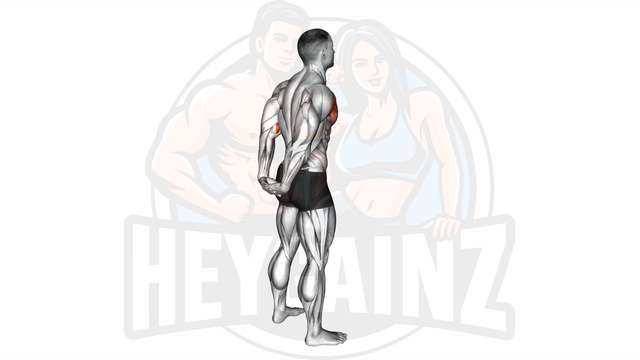
Instructions:
- 1Stand tall with your feet hip-width apart
- 2Cross your arms behind your back and hold onto your left elbow with your right hand
- 3Gently pull your left elbow to the right
- 4Hold this position for up to 30 seconds, then switch sides
- 5Repeat 2-3 times each side
Tips:
- Keep your chest lifted and your shoulders down
- Avoid pulling too hard to prevent strain
- Do these stretches regularly to increase shoulder mobility
- Remember to breathe evenly throughout the exercise
Standing Reverse Shoulder Stretch: A Guide to Releasing Tension
The Standing Reverse Shoulder Stretch is an effective exercise aimed at relieving tension in the shoulders and upper back. This stretch requires no equipment and is an excellent movement for anyone seeking to enhance their flexibility and overall shoulder health.
Benefits of the Stretch
This stretch targets the muscles in the back of the shoulders, promoting better posture and alleviating discomfort that can arise from long hours of sitting or repetitive upper body activities. Incorporating this stretch into your routine can also be beneficial for those who experience pain during exercises like the standing shoulder press.
How to Perform the Standing Reverse Shoulder Stretch
- Stand with your feet shoulder-width apart.
- Extend your arms out to the side at shoulder height, palms facing forward.
- Cross one arm over the other at the elbows, then grasp the opposite shoulder.
- Gently pull your shoulders back and down, breathing deeply as you hold the stretch.
- Hold for 15-30 seconds, then switch arms.
Tips for a Successful Stretch
- Maintain good posture: Keep your back straight and avoid hunching your shoulders.
- Breathe deeply: Focus on your breath to enhance relaxation and increase the effectiveness of the stretch.
- Don’t force it: Stretch to a point of mild discomfort, avoiding any sharp pain.
Related Concerns
If you experience discomfort during other exercises, such as the standing shoulder press, it may be worthwhile to incorporate the Standing Reverse Shoulder Stretch into your pre- or post-workout routine. This may help alleviate pain in the lower back or neck area related to shoulder tension.
Conclusion
Incorporating the Standing Reverse Shoulder Stretch into your routine can significantly enhance shoulder mobility and reduce discomfort, making it a valuable addition for anyone looking to maintain an active lifestyle.